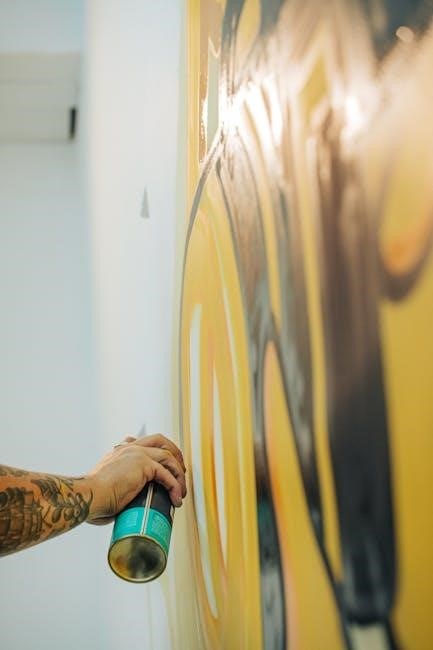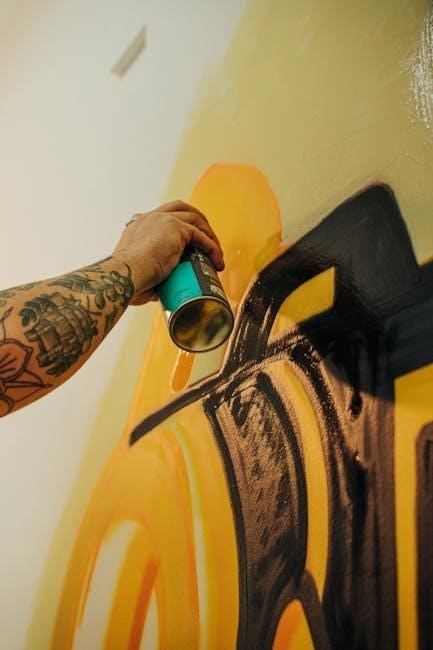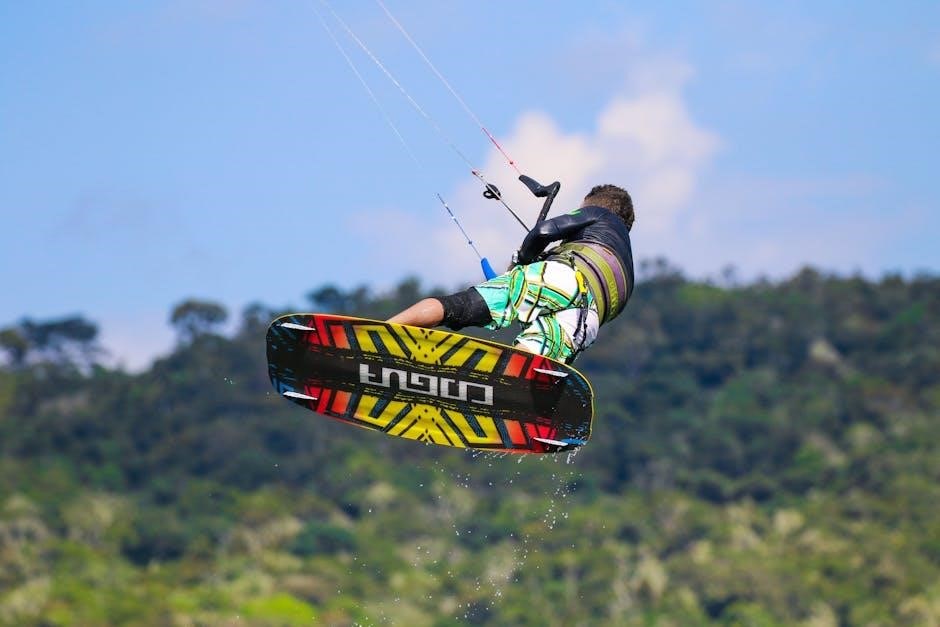graco spray tip guide
Graco spray tips are essential for achieving professional-grade results in painting projects․ They offer precise control over fan width and orifice size, ensuring optimal coverage and finish․ This guide covers selection, maintenance, and optimization techniques to maximize performance and minimize overspray, helping you choose the right tip for any project․
Overview of Graco Spray Tips
Graco spray tips are designed to deliver precise, high-quality results in various painting and coating applications․ Each tip is engineered with specific orifice sizes and fan widths to suit different materials, from thin varnishes to thick coatings․ Available in a range of types, including standard, wide-fan, and fine-finish options, these tips cater to diverse project needs․ Color-coded for easy identification, they ensure compatibility with Graco sprayers․ Proper maintenance, such as regular cleaning and storage, extends their lifespan․ Understanding the basics of Graco spray tips helps users optimize performance, reduce overspray, and achieve professional-grade finishes․ They are a key component in ensuring efficient and effective spraying outcomes․
Importance of Choosing the Right Spray Tip
Selecting the correct Graco spray tip is crucial for achieving optimal results in painting and coating projects․ The right tip ensures proper atomization, consistent coverage, and minimal overspray, while the wrong choice can lead to uneven finishes and material waste․ Fan width and orifice size determine the spray pattern and material flow, making them critical for specific applications․ Compatibility with your sprayer and the material being used is essential for performance and durability․ A well-chosen spray tip enhances efficiency, reduces waste, and ensures a professional-grade finish․ It also prevents common issues like clogging and wear, extending the tip’s lifespan․ Choosing the right tip is key to achieving desired outcomes and maintaining equipment performance․

Understanding Spray Tip Specifications
Understanding spray tip specifications is crucial for optimal painting results․ Tips are marked with numbers indicating orifice size and fan width, affecting material flow and coverage․ Color coding helps identify compatibility with specific materials, ensuring proper application and minimizing waste․
What the Number on the Spray Tip Means
The number on a Graco spray tip indicates its orifice size and fan width, crucial for determining material flow and coverage․ A larger number means a bigger orifice, suitable for thicker coatings, while a smaller number is ideal for finer finishes․ This numbering system helps users match the tip to their specific project needs, ensuring efficiency and quality․ Understanding this code is essential for selecting the right tip and achieving professional results․
Orifice Size and Fan Width Explained
The orifice size of a Graco spray tip determines the amount of material that can flow through it, while the fan width controls the spread of the spray pattern․ A larger orifice size allows for thicker coatings and higher flow rates, making it ideal for heavy-duty projects․ Conversely, a smaller orifice size is better suited for finer finishes and detailed work․ The fan width, measured in inches, indicates how wide the spray pattern will be․ Together, these specifications help users achieve the desired coverage and finish for their specific application, ensuring efficiency and precision in painting projects․
How to Read Spray Tip Codes
Graco spray tip codes are designed to provide quick and essential information about the tip’s specifications․ These codes typically consist of a combination of numbers and letters, which indicate the orifice size, fan width, and material compatibility․ For example, a code like “513” refers to a specific orifice size and fan width, while color coding helps identify the tip’s intended use․ Understanding these codes allows users to select the right tip for their project, ensuring optimal performance and desired results․ Always consult the manufacturer’s guide for a detailed breakdown of the coding system to make informed decisions․

Spray Tip Selection Guide
Selecting the right Graco spray tip is crucial for achieving desired results․ Consider project requirements, tip specifications, and material compatibility to ensure optimal performance and finish quality․
Factors to Consider When Choosing a Spray Tip
When selecting a Graco spray tip, consider the project’s material, such as paint, stain, or coating thickness․ The sprayer’s maximum pressure and tip size compatibility are crucial․ Fan width and orifice size determine coverage and finish quality․ Color coding on tips indicates suitability for specific materials․ Ensure the tip matches the sprayer’s specifications to avoid damage․ Additionally, think about the desired finish—smooth, textured, or specialized․ Proper alignment of these factors ensures efficient spraying and professional results, minimizing overspray and material waste․

Matching the Spray Tip to Your Sprayer
Matching the spray tip to your sprayer is crucial for optimal performance․ Always check the sprayer’s maximum tip size and pressure rating to ensure compatibility․ The orifice size of the tip must align with the sprayer’s pressure output to prevent damage or poor performance․ Consult the manufacturer’s compatibility chart to verify tip suitability․ Additionally, consider the sprayer’s flow rate and the material viscosity being used․ Mismatched tips can lead to issues like excessive overspray or insufficient coverage․ Proper alignment ensures smooth operation, consistent results, and extends the lifespan of both the sprayer and the tip․ This step is vital for achieving professional-grade finishes․
Material Compatibility: Paints, Stains, and Coatings
Choosing the right Graco spray tip for your material is essential for a flawless finish․ Paints, stains, and coatings vary in viscosity and solvent base, requiring specific tip orifice sizes․ For example, water-based paints work well with smaller orifice tips, while thicker coatings need larger ones․ Solvent-based materials may require specialized tips to prevent clogging․ Always consult the manufacturer’s compatibility chart to ensure the tip matches your material․ Using the wrong tip can lead to poor atomization, uneven coverage, or even equipment damage․ Proper material compatibility ensures smooth application, reduces waste, and achieves professional results․ This step is critical for both efficiency and quality in your projects․

Spray Tip Types and Applications
Graco spray tips come in various types, each designed for specific materials and projects; From fine finishes with small orifice tips to heavy coatings with large ones, they adapt to your needs, ensuring optimal performance for paints, stains, and specialized coatings․
Different Types of Graco Spray Tips
Graco spray tips are categorized by their orifice size and fan width, with each type suited for specific applications․ The smallest tips, like the 210 series, are ideal for fine finishes with thin materials such as varnishes․ Medium-sized tips, such as the 310 and 410 series, handle general painting tasks with latex and acrylics․ The largest tips, like the 510 and 610 series, are designed for heavy-duty coatings and thick materials․ Additionally, specialized tips like the Reverse Tip and the Fast-Flo Tip offer unique features for minimizing overspray and increasing efficiency․ Each tip’s color coding simplifies identification and selection, ensuring optimal performance for any project․
Best Spray Tips for Specific Projects
Selecting the right Graco spray tip ensures optimal results for various projects․ For fine finishes, such as trim or furniture, the 210 or 310 tips are ideal due to their narrow fan width and smaller orifice size, reducing overspray․ The 410 and 510 tips excel with medium to heavy materials, making them perfect for walls and ceilings․ Thicker coatings, like textured finishes, benefit from the 610 tip’s larger orifice․ Specialized tips, such as the Reverse Tip, are designed to spray in multiple directions, ideal for intricate surfaces․ Choosing the correct tip based on material viscosity and desired finish ensures a professional outcome, enhancing efficiency and minimizing waste․
Specialized Tips for Unique Applications
Graco offers specialized spray tips tailored for unique applications, ensuring precise results․ The Reverse Tip allows spraying in multiple directions, ideal for corners and intricate surfaces․ For thick coatings or textured finishes, the 610 tip’s larger orifice size is perfect․ Yellow tips, such as the LL5, are designed for solvent-based paints and line marking․ These specialized tips solve specific challenges, like uneven surfaces or high-viscosity materials, enhancing versatility․ By matching the tip to the project’s demands, users achieve superior outcomes with reduced material waste, making them indispensable for specialized tasks․ This ensures Graco spray tips meet diverse needs across various industries and applications․

Spray Tip Maintenance and Care
Regular cleaning and proper storage are crucial for spray tip longevity․ Avoid letting paint dry on tips and use solvents for thorough maintenance to ensure optimal performance․
Cleaning and Storage Tips
Cleaning your Graco spray tips immediately after use is crucial to prevent paint from drying and clogging the orifice․ Use a solvent recommended for your paint type to thoroughly flush out residue․ For storage, keep tips in a protective case or the Graco Storage Box to avoid damage․ Always allow tips to air dry completely before storing to prevent rust or corrosion․ Regular maintenance ensures optimal performance and extends the life of your spray tips․ Proper care also reduces the risk of clogs and maintains consistent spray patterns for professional results․

Common Issues and Troubleshooting
Common issues with Graco spray tips include clogged orifices, uneven spray patterns, and reduced flow rates․ Clogs often occur due to dried paint or debris, which can be resolved by soaking the tip in a solvent and cleaning with a small brush or needle․ If the spray pattern is uneven, check for proper alignment and ensure the tip is compatible with your sprayer․ Incorrect pressure settings can also cause issues; refer to your sprayer’s manual for optimal pressure ranges․ For persistent problems, consult Graco’s troubleshooting guide or contact customer support for assistance․ Regular maintenance and proper storage can help prevent these issues, ensuring consistent performance․

Optimizing Spray Performance
Optimizing spray performance involves adjusting pressure, minimizing overspray, and achieving a smooth finish․ Proper tip selection and maintenance are crucial for consistent results․ Adjust settings as needed for best outcomes․
Adjusting Spray Pressure for Best Results
Adjusting spray pressure is crucial for achieving optimal results with Graco spray tips․ Proper pressure ensures consistent material flow and minimizes overspray․ Start with the manufacturer’s recommended settings for your specific tip and material․ Lower pressure reduces material waste but may lead to incomplete coverage, while higher pressure ensures better coverage but risks excessive overspray․ Experiment with small adjustments to find the perfect balance for your project․ Always consider the tip’s orifice size and fan width when tuning pressure․ Maintain steady gun movement to avoid uneven layers․ Correct pressure adjustment enhances efficiency, reduces waste, and delivers a smooth, professional finish․
Minimizing Overspray
Minimizing overspray is key to achieving a clean, professional finish․ Start by selecting the right Graco spray tip size for your material and project․ A smaller orifice reduces overspray but may require multiple coats․ Maintain the recommended spray gun distance from the surface—typically 12-18 inches․ Keep the gun perpendicular to the surface and move it steadily at a consistent pace․ Avoid excessive pressure, as it disperses material widely․ Use low-pressure settings for thin materials like stains․ Proper tip alignment and angle also reduce overspray․ Practice on scrap material to refine your technique․ By optimizing these factors, you can significantly reduce material waste and achieve a smoother finish․
Tips for Achieving a Smooth Finish
Achieving a smooth finish with Graco spray tips requires careful preparation and technique․ Always choose the right tip for your material viscosity—thicker coatings need larger orifices, while thinner materials work best with smaller ones․ Ensure the surface is clean, dry, and properly prepared․ Maintain a consistent spray gun distance (12-18 inches) and keep the gun perpendicular to the surface; Avoid excessive pressure, as it can create texture․ Work in a steady, controlled motion, overlapping each pass slightly․ For optimal results, apply thin, even coats, allowing each to dry before recoating․ Proper tip alignment and angle are also critical for uniform coverage and a professional finish․

Advanced Spray Tip Techniques
Advanced techniques involve experimenting with spray angles for varied textures, layering strategies for smooth finishes, and adjusting pressure based on material viscosity․ Mastering these techniques ensures professional results and minimizes overspray․
Using Different Spray Angles

Experimenting with spray angles enhances finish quality․ Holding the sprayer at 90 degrees ensures even coverage, while angled spraying creates textures or reaches corners․ Vertical and horizontal techniques optimize material flow, reducing overspray and improving efficiency․ Proper angling prevents streaks, ensuring smooth surfaces․ Adjusting angles based on surface type and material viscosity is key․ Practice on test surfaces to refine skills, mastering how angles affect finish․ This technique is crucial for professionals and DIYers aiming for flawless results in various projects․
Layering and Buildup Strategies
Layering and buildup strategies are vital for achieving desired thickness and durability․ Thin, even coats prevent sagging and ensure proper adhesion․ Allow each layer to dry before applying the next, following manufacturer guidelines․ This method minimizes runs and bubbles, enhancing the finish․ For heavy-duty applications, gradually increasing coat thickness is effective․ Maintain consistent spray pressure and angle to ensure uniform buildup․ Proper layering extends the lifespan of coatings, especially in industrial or high-wear environments․ This approach also helps in achieving a smooth, professional finish, making it ideal for both small and large-scale projects․
Mastery of Graco spray tips involves understanding selection, maintenance, and application techniques․ Proper use enhances project outcomes, ensuring efficiency and professional-quality finishes every time․
Graco spray tips are crucial for achieving precise control and professional results in painting projects․ Understanding orifice size, fan width, and material compatibility ensures optimal performance․ Proper tip selection, based on the sprayer’s capabilities and project requirements, minimizes overspray and improves efficiency․ Regular cleaning and maintenance extend the life of the tips and maintain consistent results․ Experimenting with spray angles and techniques can enhance finish quality․ By mastering these elements, users can unlock the full potential of Graco spray tips, ensuring flawless outcomes for various applications․ This guide provides a comprehensive foundation for selecting, using, and caring for Graco spray tips effectively․
Final Tips for Mastering Graco Spray Tips
Mastering Graco spray tips requires practice and experimentation to achieve professional results․ Always adjust spray pressure according to material viscosity and project needs․ Use proper spray angles to control fan width and minimize overspray․ Maintain equipment regularly to prevent clogs and ensure longevity․ Experiment with different tip sizes for varied coverage and detail work․ Consider material compatibility to avoid damage or poor performance․ Finally, apply consistent, steady strokes for a smooth finish․ By following these tips, you’ll optimize your spraying experience and achieve flawless results across all projects․
